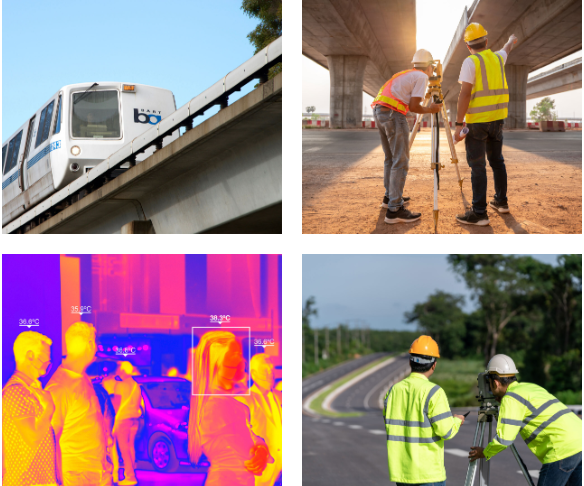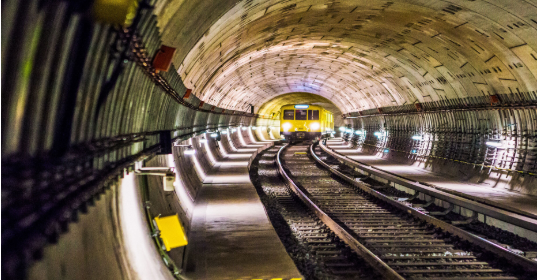Transportation is a Vital Part of Society
Every day, millions of people leave their homes and travel by road, rail, air, or water to get where they need to go. Effective use of public or private transport relies on the ability to do so in a safe and efficient manner. This means that the mitigation of hazards, accidents, and delays is a must.
Currently, heavy use of CCTV and other optical camera streams are deployed to monitor roads, highways, parking lots, transportation hubs, train/subway stations, level crossings, and more. While they have advantages, like 24/7 remote access to streams, they also have some limitations, such as the adverse effects of weather and surrounding illumination. The introduction of thermal camera technology to existing systems can elevate safety as well as improve efficient and reliable maintenance of equipment and mechanics to their full potential.
Currently, heavy use of CCTV and other optical camera streams are deployed to monitor roads, highways, parking lots, transportation hubs, train/subway stations, level crossings, and more. While they have advantages, like 24/7 remote access to streams, they also have some limitations, such as the adverse effects of weather and surrounding illumination. The introduction of thermal camera technology to existing systems can elevate safety as well as improve efficient and reliable maintenance of equipment and mechanics to their full potential.
Implementing Thermography to Improve Transportation Safety
Thermal imaging is applicable in many ways when it comes to transportation safety. First, it drastically improves visibility. Current optical systems are limited by things like sun glares and shadows that effectively hide people, animals, and cars that may be stationed in these cameras’ blind spots. Because thermal imaging relies on temperature differences to produce data and is unaffected by light, it has a strong advantage in detecting objects otherwise missed. Similarly, thermal imaging is more reliable in adverse weather conditions, with the ability to see through rain, fog, smoke, and produce clear imaging at night.
These important features provide better detection of pedestrians, animals, rail trespassing, level crossing hazards, and fires. Being able to detect these potential obstructions or hazards early allows for quicker reaction and response, potentially saving lives, preventing damage, and avoiding delays. Using innovative AI technology allows for advanced detection, license plate recognition, and security measures that further improve safety.
These important features provide better detection of pedestrians, animals, rail trespassing, level crossing hazards, and fires. Being able to detect these potential obstructions or hazards early allows for quicker reaction and response, potentially saving lives, preventing damage, and avoiding delays. Using innovative AI technology allows for advanced detection, license plate recognition, and security measures that further improve safety.
Thermal Imaging Makes Transportation-Related Inspections Easier
To provide safe transportation means and methods, the infrastructure, systems, and mechanisms must all be in optimal operational condition. Otherwise, there are risks of malfunctions and accidents, which could potentially cause delays, damage to infrastructure and equipment, or, in the worst case, harm to people.
The use of thermal cameras has made the detection of potential structural stress or damage in roads, highways, railways, and bridges more effective. Temperature readings allow for visibility of heat anomalies in concrete or steel components and detection of water leaks in bridges or buildings. It can also be used to identify overheating issues in vehicles and other mechanical equipment, such as train cars, subways, and buses. The ability to address possible anomalies before they become full-blown failures is critical in avoiding delays and potentially dangerous situations.
The use of thermal cameras has made the detection of potential structural stress or damage in roads, highways, railways, and bridges more effective. Temperature readings allow for visibility of heat anomalies in concrete or steel components and detection of water leaks in bridges or buildings. It can also be used to identify overheating issues in vehicles and other mechanical equipment, such as train cars, subways, and buses. The ability to address possible anomalies before they become full-blown failures is critical in avoiding delays and potentially dangerous situations.
Features
- •High Visibility: Unhindered by adverse weather or illumination level.
- •Early Detection: Ability to recognize issues before they become a major danger.
- •AI Technology: Intelligent recognition and analysis contribute advanced data and capabilities.
- •Improved Safety: Better visibility and early detection save lives, infrastructure, and equipment.
Conclusion
Thermal imagery has made a large impact on the transportation sector and its ability to provide safe, efficient methods of transport to the public. Whether that means keeping the roads and railways clear from potential hazards with real-time detection and quick response or ensuring that infrastructure and equipment are stable and operating correctly, the use of thermography in tandem with current optical camera systems ensures optimal visibility and safety.



